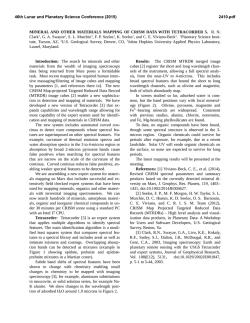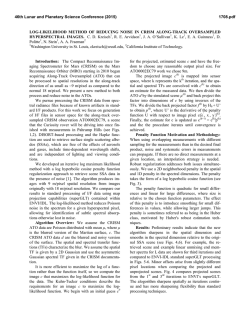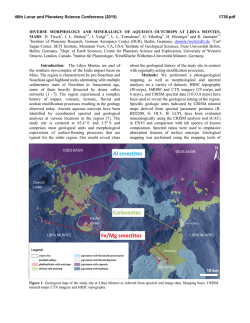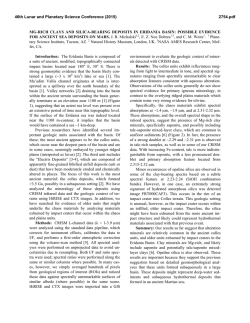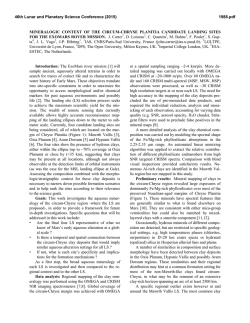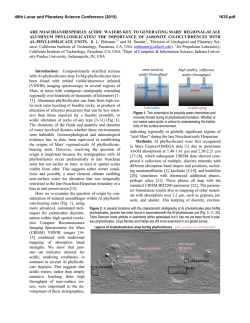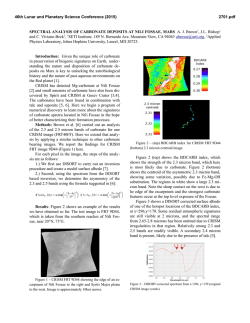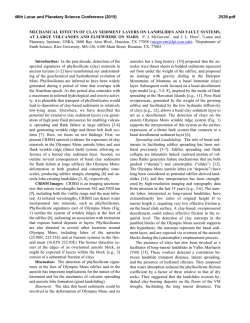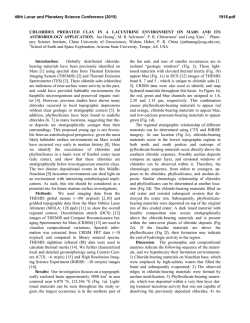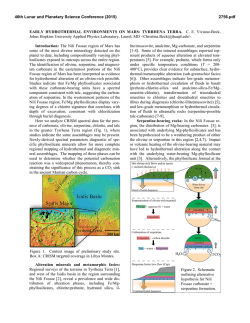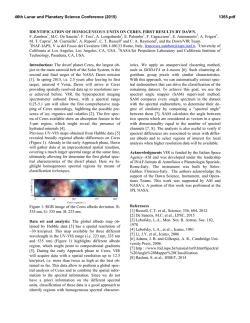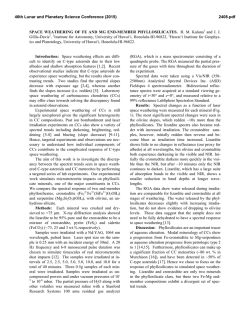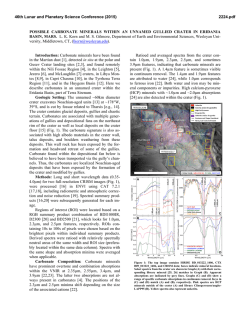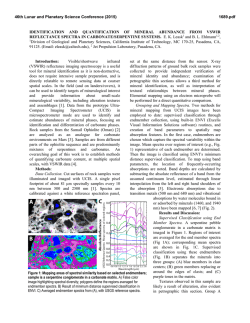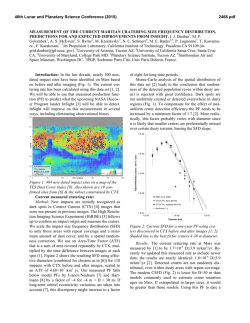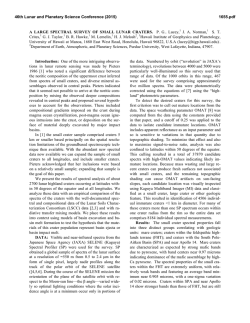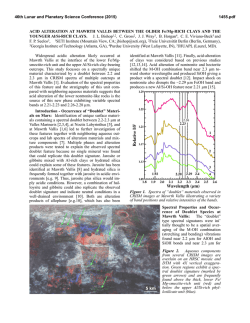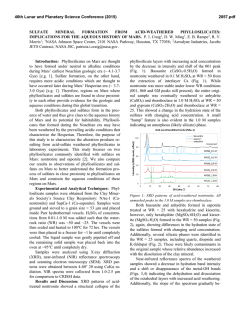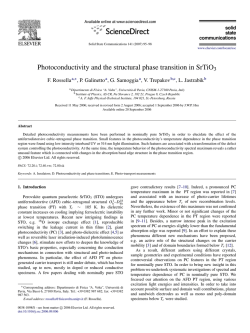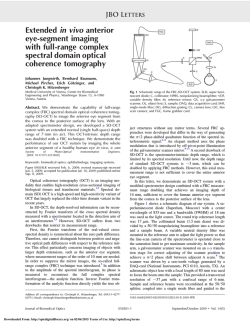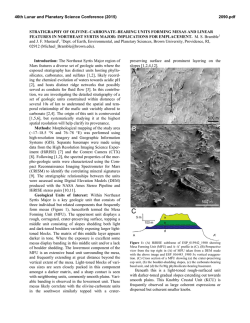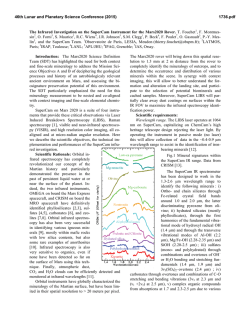
nontronite detections in nili fossae based on an impact
46th Lunar and Planetary Science Conference (2015) 2852.pdf NONTRONITE DETECTIONS IN NILI FOSSAE BASED ON AN IMPACT-ALTERED NATURAL NONTRONITE SAMPLE RESEMBLE REGIONAL-SCALE SPECTRAL VARIABILITY PREVIOUSLY ASSOCIATED WITH PHYLLOSILICATE DIAGENESIS. L. R. Friedlander1 and T. D. Glotch1, 1Geosciences Department, Stony Brook University (255 Earth and Space Sciences Building, Stony Brook, NY 11794-2100, [email protected]). Introduction: There is evidence for extensive clay mineral deposits on Mars from visible near-infrared (VNIR) remote sensing techniques [1-8]. Most of these identifications have been made in the older, heavily bombarded southern highlands of Mars [9]. Several are associated directly with impact craters, or with deposits of impact ejecta. For example, in [6] several occurrences of characteristic spectral features indicative of specific clay mineral species were described within craters surrounding the Nili Fossae. Phyllosilicatebearing outcrops have been identified on the rim of Endeavor Crater using orbital remote sensing data [10], and saponite has been identified in the center of a crater within the Mawrth Vallis region [11]. Indeed, craters have been specifically targeted for investigation as self-contained locations where the martian subsurface can be directly probed [12,13]. The use of craters as “windows [12]” into the martian subsurface may be problematic for remote sensing. The impacts that form craters also expose the minerals present at the time of impact to thermal and shock alteration. Both of these processes have been previously shown to alter mineral structures and spectral signatures [14-17]. This abstract explores the possibility that impact-induced spectral changes may produce some of the regional-scale spectral variability observed by remote sensing on Mars. Interestingly, the impactinduced changes observed for a natural nontronite sample occassionaly overlap and may be conflated with spectral change that has previously been associated with clay mineral diagenesis on Mars [6, 18-20]. Materials and Methods: The Clay Minerals Society source clay NAu-1 (nontronite) was ground and separated to its < 2 µm size-fraction and sent to the Flat Plate Accelerator at NASA’s Johnson Space Center where it was exposed to a serious of experimental impacts at six controlled peak impact pressures: 10.2, 19.7, 25.2, 30.6, 34.6, and 39.1 GPa. VNIR reflectance spectra (0.25 – 2.5 µm) of the returned (~0.15 g) impact-altered samples were collected using an ASD Instruments (now PANalytical) Field Spec 3 Max Spectroradiometer fitted with an 8-degree field of view foreoptic. These spectral data were then used in the analysis of a Compact Reconnaissance Imaging Spectrometer for Mars (CRISM) image from the Nili Fossae region. CRISM Image Processing and Analysis. We processed CRISM image FRT000097E2 (Figure 1) using the latest version of the CRISM Analysis Toolkit (CAT: version 7.2.1) for ENVI/IDL Classic (version 5.1) image processing software. FRT000097E2 contains image data in the most up-to-date format available from the CRISM archive (TRR3) and was radiometrically calibrated as well as converted to I/F from raw CRISM experiment data record (EDR) prior to download. We performed atmospheric correction on this image using the latest version of the volcano-scan method contained within CAT and converted CRISM I/F to apparent surface reflectance using the systematic processing tools embedded in CAT [21]. Regions of interest were selected using the spectral angle mapping (SAM) tool in ENVI/IDL to locate areas within the CRISM image with spectral features resembling those of target laboratory spectra. Individual spectra were then extracted from these regions, ratioed and compared to laboratory spectra directly. Figure 1. Local context of CRISM image FRT000097E2 from the Nili Fossae region. Results: Several regions of FRT000097E2 were expected to contain phyllosilicates (Figure 2a), but we were especially interested in two small craters within the image (Figure 2b) for what they might reveal about the relationship between regional spectral variability and impact processes. The regions in and around these craters were detected by the SAM algorithm as containing spectral features consistent with both impact altered and diagenetic phyllosilicates (Figure 3). Spectra extracted from these regions were then compared to laboratory spectra of impact-altered nontronite and several diagenetic clay minerals. This comparison showed that some regional variability previously attributed to diagenesis may be partially explained by impact alteration, especially in heavily bombarded regions (Figure 4). 46th Lunar and Planetary Science Conference (2015) Figure 2. False-color CRISM image showing the distribution of phyllosilicates (red), olivine (green) and low-Ca pyroxene (blue) within FRT000097E2 overlain on HiRISE image PSP006778_1995 from the same geographic region (a). The overlay highlights the relationship between clay mineral deposits and two small craters in the southwest corner (b). 2852.pdf Figure 3. SAM pixel classifications overlain on a singleband 1.3 µm image of FRT000097E2. End-member spectral comparisons: impact-altered nontronite after impacts at 39.1 GPa (a), CRISM library nontronite NDJB26 (b), CRISM library smectite BKR1JB006 (c), CRISM library illite LAIL01 (d), CRISM library chlorite LACL14 (e), and illite with a relaxed spectral angle differential of 0.100 radians (f). Arrows indicate locations of extracted spectra. Discussion: NAu-1 nontronite contains and Al-rich contaminant, most likely kaolinite. The persistence of these Al bands in our VNIR reflectance results likely contributes to the observed spectral changes. However, pure minerals are rare on planetary surfaces and so the effect of impacts on the spectroscopic signature of this natural mineral mixture and its similarity to “diagenetic” trends warrants further detailed investigation. References: [1] Bibring J.-P. et al. (2006) Science, 312, 400-404. [2] Poulet F. et al. (2007) JGR, 112, E08S02. [3] Loizeau D. et al. (2007) JGR, 112, E08S08. [4] Mangold N. et al. (2007) JGR, 112, E08S04. [5] Mustard J. F. et al. (2009) JGR, 114, E00D12. [6] Ehlmann B. L. et al. (2009) GRL, 37, L06201. [7] Ehlmann B. L. et al. (2013) Space Sci. Rev., 174, 329-364. [8] Michalski J. R. et al. (2010) Icarus, 206, 269-289. [9] Carter J. et al. (2013) JGR: Planets, 118, 831-858. [10] Wray J. J. et al. (2009) GRL, 36, L21201. [11] Mckeown N. K. et al. (2009) JGR, 114, E00D10. [12] Schwenzer S. P. et al. (2009) MEPAG white paper. [13] Schwenzer S. P. et al. (2010) LPS XLI, Abstract #1589. [14] Friedlander L. R. et al. (2012) LPS XLIII, Abstract #2520. [15] Friedlander L. R. et al. (in review) JGR: Planets. [16] Che C. et al. (2011) JGR, 116, E05007. [17] Gavin P. et al. (2013) JGR: Planets, 118, 1-16. [18] Milliken R. E. (2014) Proc. 8th Intl. Conf. Mars, Abstract #1253. [19] Bishop J. L. et al. (2013) Plan Space Sci., 86, 130-149. [20] Viviano C. E. et al. (2013) JGR: Panets, 118, 1858-1872. [21] http://pdsgeosciences. wustl.edu/missions/mro/crism.htm. Figure 4. Extracted spectra from FRT000097E2 showing regional variability (a) compared to spectral variability between primary phyllosilicates and diagenetic products (b) and spectral change produced by impact alteration (c).
© Copyright 2025
